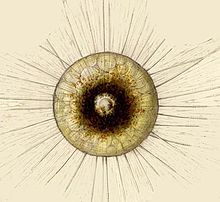Bikont
| Bikonts | |
|---|---|
 |
|
| A radiolarian | |
| Scientific classification |
|
| Domain: | Eukaryota |
| (unranked): | Bikonta Cavalier-Smith, 1993 |
| Subgroups | |
| Synonyms | |
|
|
A bikont ("two flagella") is any of the eukaryotic organisms classified in the group Bikonta. Many single-celled members of the group, and the presumed ancestor, have two flagella.[1]
Enzymes[edit]
Another shared trait of bikonts is the fusion of two genes into a single unit: the genes for thymidylate synthase (TS) and dihydrofolate reductase (DHFR) encode a single protein with two functions.[2]
The genes are separately translated in unikonts.
Relationships[edit]
Some research suggests that a unikont (a eukaryotic cell with a single flagellum) was the ancestor of opisthokonts (Animals, Fungi, and related forms) and Amoebozoa, and a bikont was the ancestor of Archaeplastida (Plants and relatives), Excavata, Rhizaria, and Chromalveolata. Cavalier-Smith has suggested that Apusozoa, which are typically considered incertae sedis, are in fact bikonts.
Relationships within the bikonts are not yet clear. Cavalier-Smith has grouped the Excavata and Rhizaria into the Cabozoa and the Archaeplastida and Chromalveolata into the Corticata, but at least one other study has suggested that the Rhizaria and Chromalveolata form a clade.[3]
References[edit]
- ^ Burki F, Pawlowski J (October 2006). "Monophyly of Rhizaria and multigene phylogeny of unicellular bikonts". Mol. Biol. Evol. 23 (10): 1922–30. doi:10.1093/molbev/msl055. PMID 16829542.
- ^ Thomas Cavalier-Smith (2006). "Protist phylogeny and the high-level classification of Protozoa". European Journal of Protistology 39 (4): 338–348. doi:10.1078/0932-4739-00002.
- ^ Burki F, Shalchian-Tabrizi K, Minge M, Skjæveland Å, Nikolaev SI et al. (2007). Butler, Geraldine, ed. "Phylogenomics Reshuffles the Eukaryotic Supergroups". PLoS ONE 2 (8: e790): e790. doi:10.1371/journal.pone.0000790. PMC 1949142. PMID 17726520.
Further reading[edit]
| Wikispecies has information related to: Bikonta |
| Wikimedia Commons has media related to Bikonta. |
- Stechmann A, Cavalier-Smith T (September 2003). "The root of the eukaryote tree pinpointed". Curr. Biol. 13 (17): R665–6. doi:10.1016/S0960-9822(03)00602-X. PMID 12956967.
- Tree of Life Eukaryotes
|
||||||||||||||||||||||||||||||||||||||||||||||||||||||||||||||||||||||||||||||||||||||||||||||